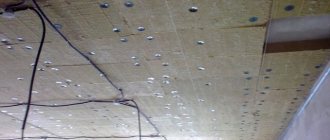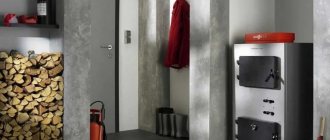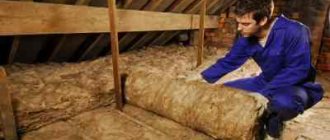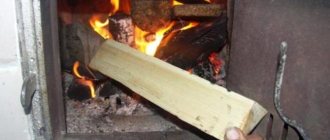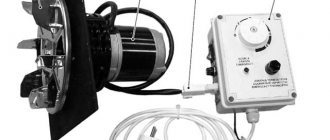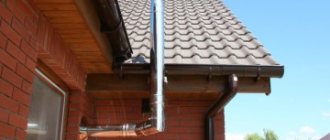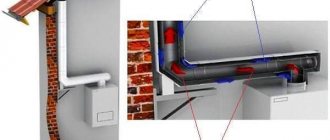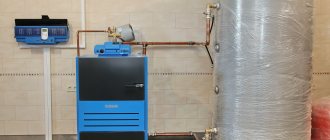- Brick
- Stainless steel kit elements
- Video about the importance of correct chimney installation
The outlet duct is one of the key elements of a room heating system. Through it, waste combustion products are discharged into the street. It can be made from different materials. We will look at what type of chimney is best for a solid fuel boiler, so that you understand how to organize the most reliable, efficient and safe design.
The correct design of the sleeve affects the stability of the draft and the efficiency of the heating device. An unsuitable pipe (too small a cross-section, with a rough internal surface) and improper installation lead to excessive soot clogging, and subsequently overheating, which leads to destruction and the release of harmful chemical compounds. The duration of operation without repair or replacement of individual elements is also very important. Therefore, already at the design stage it is necessary to clearly understand what to give preference to: stainless steel, ceramics or brick.
Requirements for the installation of chimneys for solid fuel boilers
- Maximum vertical design. Ideally, it should look straight up, then the aerodynamic force for removing combustion products will be most effective.
- The cross-sectional area of the channel must be larger than that of the pipe. It is also possible that they can be equal, but this is a last resort.
- The height of the pipe is not less than the required figure in the heating equipment passport. When arranging the sleeve, the level and angle of the roof, as well as the distance to the ridge, are taken into account.
- It is necessary to make an acceleration section that will stimulate traction. To do this, install a tee, immediately behind which a 1 m long passage is created perpendicular to the roof, and only after that other sections are created.
- The presence of a deflector is mandatory (if there is wind support).
Semolina casserole with pumpkin and dried fruits
If children do not want to eat healthy pumpkin, you can hide it in a delicious semolina casserole. Dried fruits in the recipe are not only a “zest”, but also additional vitamins. If desired, they can be replaced with pieces of fresh fruit. For example, pear and apple, plum and peach are suitable. Any combination of fruits in semolina dough will be useful.
Ingredients:
- 200 g semolina;
- half a glass of milk;
- 50 ml filtered water;
- 25 g butter;
- 60 g pumpkin;
- 1 tbsp. l. Sahara;
- a pinch of salt;
- 100 g of any seedless dried fruit (dried apricots, prunes, raisins, dogwood);
- two raw chicken eggs;
- 50 g of premium wheat flour;
- 11 g baking powder.
Cooking method:
1. Rinse in warm water and soak dried fruits. Cut them into small pieces (except for raisins, do not cut them).
2. Cook semolina porridge in a saucepan. To do this, mix water with milk (take cold), add semolina and butter. Add sugar and salt. Stir and leave for now.
3. Peel the pumpkin and grate it on a fine grater or, using a blender, grind it into puree. Add to porridge.
4. Place the pan on the fire and, constantly stirring with a whisk or tablespoon, bring the porridge to a boil. Remove from heat and cool for a few minutes, stirring with a whisk.
5. Add eggs, flour and baking powder to the porridge. Stir until smooth and add dried fruits. Mix again.
7. Place the semolina porridge casserole dough on a baking sheet lined with paper or foil. If desired, grease it with additional oil.
8. Place the dish to bake until done.
You can serve semolina casserole with pumpkin and dried fruits with a glass of milk or a cup of tea. Casseroles prepared according to these recipes will become your favorite breakfast. It’s easy and simple to delight your loved ones with a new casserole recipe every day. Just write down the recipes and create amazing desserts from ordinary semolina!
Additional features of a chimney for a solid fuel boiler
It is necessary that its pipe rises at least 70 cm above the ridge. At the same time, it is important not to cover it with a fungus (umbrella), otherwise the soot will settle on its walls and eat through it. Sandwich elbows and similar elements should be connected at an angle of 45° to prevent the rod from tipping over. And any shaft (gas silicate, brick or expanded clay concrete) must be lined with a stainless steel chimney.
The channel must be lined with a material with particularly high heat resistance. Keep in mind that when burning wood or coal, the temperature of the exhaust gases may not exceed 300°C and even significantly exceed this mark. This means that the walls of the sleeve must withstand the most severe heat.
In addition, chimney pipes for solid fuel wood boilers must meet the following requirements. Ability to withstand negative environmental factors: condensation and high temperature.
During the heating process, the channel material must resist the destructive effects of moisture and the acids and other aggressive impurities it contains, and not release any volatile compounds.
Reliability
The service life of a truly good heating system is measured not in years, but in decades, during which it remains safe. To ensure such high durability, it is necessary not only to properly organize the removal of waste gases, but also to select a modern heating unit and connect it correctly.
Traction
In the event that it turns out to be insufficient, soot will settle on the inner walls of chimneys for solid fuel boilers, gradually clogging the passage and thus preventing the gases from escaping in full. If the problem is not corrected, more and more combustion products will settle, and sooner or later there will come a time when they go inside the house, which can lead to poisoning of the residents.
This phenomenon occurs due to the difference in temperatures and atmospheres when air tends to a zone of low pressure. Traction force can be partially increased by making smart design decisions, because it depends on the following factors:
- length of the vertical section;
- the number of turns and bends, and their angle of inclination.
Their number in general is not limited by any rules. But it is worth remembering the total size of the horizontal projections of all inclined surfaces from the axis of the entrance from the boiler to the chimney (at the lowest point) to the head on the roof (at the top). The amount cannot exceed two meters. The optimal height of the chimney from the grate to the top is 5 m; in the presence of horizontal sections, the slope of which reaches 45º, the height is increased by the number of their longitudinal projections.
In general, the straighter the shaft, the better the passage of exhaust gases, the more stable the draft, and vice versa. This is why it is so important to avoid transitions at 90° angles. In exceptional cases, the use of one transition is permitted. And the horizontal section should be no more than 1 m.
Calculation example
To choose the best option for heating your home, you should pay attention to how much electricity will be used when operating the system and correctly calculate the costs.
Consumption of 1.03 kW/hour of electricity at the output gives about 1 kW/hour of heat energy. The cost of one kW/hour varies in different regions. To calculate, let’s take the cost of consumed electricity as 3.20 rubles. for 1 kW/hour. Thus, the cost of a kilowatt of electricity will be equal to 1.03 * 3.2 = 3.296 rubles.
Heating engineers calculate the boiler power based on the fact that heating 10 m2 requires 1 kW of power. Let's say we heat a small house with an area of 100 m2, and the heating season lasts 7 months and the unit is in operation for approximately half of this time.
If the boiler operated continuously, then during the heating season it would be needed: 10 kW x 24 hours x 30 days x 7 months = 50,400 kW. But since it does not work a full day, but only half, we divide the resulting number by two 50400 kW /2 = 25200 kW. How much money will be spent is calculated as follows - 25200 * 3.2 = 80640 rubles. This is the amount it will cost to heat a house for the entire heating season.
How to calculate the cross-section of a chimney
Calculated using the following formula:
D = V/v, where:
- D – the size we need, in m2;
- V – volume of fuel consumed, m3;
- v – speed of movement of exhaust gases, m/s.
The cross-sectional shape can be any, but round is preferable to rectangular, since, as it rises, the steam twists in a spiral, and unnecessary parts (for example, corners) create obstacles for it, forcing it to change its trajectory, push off from the walls and, as a result, worsen the draft. A rough surface is also a hindrance.
If the found diameter turns out to be smaller than that of the pipe, it will need to be increased to an equal value, otherwise you risk causing a drop in pressure in the channel.
| Boiler power, kW | Internal section, mm | Minimum height, m |
| 16 | 200x200 | 6 |
| 16 | Diameter (Ø) 200 | 7 |
| 16 | 150x150 | 10 |
| 16 | Ø 150 | 12 |
| 32 | 200x200 | 10 |
| 32 | Ø 200 | 12 |
| 32 | 150x150 | 18 |
| 32 | Ø 150 | 20 |
| 45 | 200x200 | 12 |
| 45 | Ø 200 | 14 |
Classification
Basically, consumers are offered three types: induction, heating element and electrode, with different technical characteristics. Induction boilers operate on the principle of an induction coil. They are quite easy to install and have high efficiency. Among the disadvantages, it is worth noting the complexity of the equipment and the need for its regular inspection by specialists.
Units based on heating elements have a simple design, but have low efficiency and heating elements that quickly fail. A person with an engineering education can make such an electric boiler for home heating with his own hands.
Electrode models are a good ratio of quality and price. The device operates on the principle of electrical conductivity of a liquid medium. The efficiency of such a boiler can reach 95%. Disadvantages include the need to annually descale the electrodes and install an ideal grounding system to prevent electric shock.
Improved type
Combined models of electric heating boilers allow you to alternate the electric heating model with gas, wood or solid-state ones. The buyer can choose the two most accessible types of fuel and purchase, for example, an electric and solid fuel heating boiler in one device according to his needs. It will be more difficult to install a combined option into the system, but the undoubted advantages of this type of heating include:
- independent choice of fuel at any time;
- efficiency.
What materials should exhaust pipes be made of?
Let's look at the options offered on the market, and also analyze the advantages and disadvantages of each.
Brick
This is a traditional chimney for a solid fuel boiler, a classic option that has been popular for ten years. Is it still relevant today, when there are several alternatives? The advantage of brick is that it can withstand temperatures up to 900°C. True, it slowly accumulates and releases heat and therefore is not entirely convenient in situations where you need to quickly warm up the premises of the house.
But there is also a minus, and a serious one, and it lies in the rapid destruction of the channel. Any, even the most accurate masonry turns out to be heterogeneous, as a result of which, over time, cracks and gaps appear between individual bricks, in which soot accumulates, steam is retained, and moisture collects. And a material such as fireclay does not withstand exposure to aggressive environments: the acids contained in the condensate corrode it within a few years.
Also, among the disadvantages can be noted:
- The high cost of materials and the laying work itself. At the same time, there are very few craftsmen who know how to lay out a chimney correctly.
- It is mandatory to have a foundation for such a chimney and to include it in the project in advance, before the start of construction.
Ceramic
They are three-layer structures, with an internal contour, internal thermal insulation and an external frame. They have a smooth surface that minimizes the accumulation of soot and does not absorb condensation. They are characterized by high tightness. With good care, they last up to 30 years, but at the same time they cost significantly more than steel ones, and the correct installation of a ceramic chimney for a solid fuel boiler in this case is possible with specialized skills. This is not the most budget-friendly choice. In this case, the installation must be planned at the stage of designing the house, since there is no possibility of installation in a finished building. Also, a foundation will be required due to the overall weight of the structure and the fixing mortar. A beginner obviously cannot cope with such a complex job, so it’s worth entrusting the job to the experts. But keep in mind that the installation speed of this chimney is lower than that of stainless steel ones, and replacing failed elements is always very difficult.
Glass
A fashionable novelty that has already achieved success in Europe. The main advantage is the original and spectacular appearance. And this is with good heat resistance and corrosion resistance.
Main disadvantages:
- price: of all the options considered, they are the most expensive;
- lack of experience of widespread use in Russia.
Steel
This category includes pipes made of high-quality alloy steel with the addition of nickel, titanium, and molybdenum. A distinctive feature is increased corrosion resistance. For stoves that operate on solid fuel and with high temperature flue gases, smoke vents made from heat-resistant stainless steel with a thickness of at least 0.8 mm should be used. When performing maintenance or repair of modular systems, it is required to follow the Code of Practice for Design and Construction SP 13-101-99.
A chimney for a solid fuel boiler made of stainless steel, when compared objectively, is the most practical option, which has the following advantages:
- high heat resistance - at a temperature of 600°C there is no deformation of the walls of the sleeve;
- corrosion resistance – the metal does not rust after prolonged contact with liquids (for example, during prolonged downpours);
- no condensation formation – when using a sandwich chimney. Elements of double-walled chimneys (sandwiches) are represented by products consisting of 2 pipes (external and internal) of different diameters. The space between them is filled with non-flammable heat-insulating material, which is made of basalt fibers. With this design, the inner pipe cools slowly, the temperature in the chimney rises above the dew point, which guarantees the avoidance of condensation;
- ease of installation with the possibility of further adjustment of the design - it will not be difficult to disassemble and/or add some elements, for example, a gate valve;
- affordable price - in comparison, this option is cheaper than brick, glass and ceramic models (with a service life of over 30 years, even in difficult climatic conditions), this is a budget but very reliable choice.
Sandwich chimneys for solid fuel boilers
In fact, they are composite sections of pipes inserted into each other with thermal insulation laid between them. Due to such multi-layering, they have a reserve of heat resistance, and therefore a high degree of fire safety, and can also boast resistance to condensation and exposure to aggressive environments. Compact, lightweight, easy to assemble.
Advantages:
- Due to their relative novelty and production features, sandwich channels have an optimal cost.
- High resistance to atmospheric pressure.
- Long service life.
- Attractive appearance.
It is these chimneys that can be found in the line of the manufacturer Ferrum. The product quality meets all standards at an affordable price.
Next we will look at how to properly install a chimney made of a steel pipe on a solid fuel boiler. Having compared and analyzed all the materials for the manufacture of the outlet channel, we propose to focus on stainless steel. Possessing sufficient heat resistance, it is ideally smooth (does not collect soot or moisture), chemically inert and, most importantly, is characterized by maximum durability at minimum cost (plus, it is not a problem to buy it in any required quantities). At a reasonable cost, you can quickly create a modern, reliable, easy-to-use and fireproof heating system for a country house or cottage, and then easily change and supplement it in the future, focusing on your needs.
One- and two-pipe heating systems
The choice of pipes is also influenced by the pipeline layout (single-pipe, two-pipe) through which the coolant moves.
The presented figure schematically shows one-pipe and two-pipe heating systems, each of which has its own advantages and disadvantages (+)
Let's look at the differences in the installation of both circuit solutions.
Option #1 - single pipe system
In this case, the “supply” departs from the boiler - the main line, which has a large diameter. It simultaneously serves both to transfer hot coolant and to collect cooled liquid.
The figure shows one of the possible boiler piping diagrams, including an anti-condensation pump and a deaerator unit (+)
Heating radiators are connected in series to the central artery. For this, two thin pipes are used, one of them receives the coolant, and the second - releases it.
In a single-pipe heating system, the liquid passes through all the radiators in turn, transferring part of the heat energy along its path.
Two types of one-pipe circuits
Based on the design features, two system options can be distinguished: flow-through and with bypasses. The flow-through design does not provide for risers, limiting itself to the direct connection of radiators on the upper floor with their counterparts located below.
When using this scheme, you must not forget about the ban on the use of control valves, since they can prevent access to the coolant flowing to the devices.
Such a system is easy to implement, but it has a number of disadvantages. The coolant in the circuit cools down quite quickly; in addition, it is impossible to repair or adjust the system without completely shutting it down.
In this figure you can clearly see the installation features of two popular types of single-pipe systems (+)
A heating system with bypasses also involves connecting radiators with risers, which are responsible for supplying the networks with coolant. At the same time, the batteries are separated from the circuit by closing links.
The coolant is distributed over all connected devices in portions at almost the same time, due to which the heated liquid cools down significantly less than in flow-through circuits.
With a heating circuit with bypasses, it is possible to adjust the temperature and repair the outgoing device without shutting down the system.
Selecting elements for a one-pipe system
The most popular option for implementing single-pipe heating schemes are steel products, which have reasonable prices and good technological characteristics. They are especially common in older apartment buildings.
When installing pipes, it is necessary to observe a slope, the value of which should exceed 5 millimeters per 1 linear meter. Such installation ensures free transfer of coolant, which will continue even in the event of a sudden or planned shutdown of the circulation pump.
In addition to steel elements, products made of plastic can be used for laying single-pipe systems. Due to the lower hydraulic resistance of polymer pipes, elements of smaller diameter can be used
For wiring the forward and return lines of a single-pipe system, elements of large diameter (<50 mm) are used, while for connecting heating radiators in an open system, structural elements with a diameter of 32 mm are sufficient.
Option #2 - effective two-pipe scheme
This version of the heating circuit provides two lines: along one of them - “supply” - the coolant is transported, which is heated in the boiler, and along the second - “return” - cooled liquid is collected, which is discharged to the heating unit.
With forced circulation, the heated liquid rises along the main riser, after which it is distributed among series-connected batteries. In systems with natural circulation, the design does not provide for return risers, and the devices are connected using the top wiring (+)
This modification of the heating system provides for parallel connection of batteries. Since the intensity of liquid circulation depends on the difference in temperature between the supply and return connections, the coldest battery will warm up faster, and, consequently, the temperature in all connected devices will be equalized.
The advantages of two-pipe systems include:
- high coolant circulation rate;
- the ability to create hidden systems with pipelines hidden in walls or floors;
- air heating efficiency;
- hydrodynamic stability of the system;
- possibility of easy connection of a device used to regulate the supply of hot water.
Two-pipe systems can be of different types:
- with bottom or top wiring;
- with associated or dead-end coolant transfer;
- natural and forced circulation (in the latter case, a circulation pump is used).
A two-pipe system is significantly more expensive than a single-pipe system, and is also more difficult to install than the latter. At the same time, this option guarantees more comfortable operating conditions.
Among the disadvantages of such a system are such factors as:
- double the number of pipes required to lay the structure, which significantly increases its cost and increases the time required for installation;
- the need to use various types of control and shut-off valves.
Despite the comments made above, it is the two-pipe system that is considered the preferable solution, especially when it comes to a network connected to autonomous boilers.
It works with greater efficiency and allows you to quickly achieve a comfortable microclimate. The compatibility of such structures with all types of boilers and various types of heating batteries also attracts attention.
Design elements for two-pipe systems
When choosing parts for the construction of two-pipe structures, it is better to give preference to polypropylene elements, although you can use other options (copper, metal-plastic) that can withstand high temperature and pressure.
Modern materials and technologies make it possible to install systems without the use of welding, and to carry out installation according to the principle of a designer. Since each pipe bend contributes to an increase in hydraulic resistance, turns should be avoided and pipes should be laid as straight as possible.
Pipes with a diameter of 50 mm are optimally suited for the supply and collection lines that are connected to the boilers. Similar parts are also used to make risers to which radiators are attached.
Connection to the supply and return of batteries is made with pipes of various diameters, the choice of which is influenced by the number of sections:
- to connect 25-35-section radiators, pipes with a diameter of 1.5 inches are required;
- 10-25 section – 1 inch;
- less than 10 sections - three quarters of an inch.
To prevent heat loss, all pipes and connections must be thermally insulated.
Installation of a chimney for a solid fuel boiler
Regardless of the material chosen, the design of any stainless chimney consists of the following elements:
- Tension clamp for secure fixation.
- Pipes - one or more hermetically connected to each other with a round or oval cross-section.
- The sliding bracket is used to attach the chimney to walls or other building structures.
- The tee is designed to change the direction of the smoke channel at an angle of 90°, is used as a cleaning element, and facilitates chimney maintenance.
- The plug is used to close the thermal insulation of the lower element of the chimney or to plug an unused branch.
- Screen - to ensure protection of the ceiling and walls of the room in accordance with fire safety standards.
- A condensate collector is a container installed at the bottom of the system, and always before the heating unit. Moisture generated as a result of steam cooling will flow into it.
- The installation platform supports the entire system and also transfers the load of the modules to the supporting structure.
- The console is a fastener that allows you to secure the pipes in a strictly vertical position.
- The damper is an important element that increases and decreases draft (if necessary), pumps air, which increases the combustion force and prevents heat loss.
- Inspection hole - is attached immediately above the condensate drain so that it can be easily drained from the system later.
- The sandwich elbow provides the required slope of the chimney in complex buildings.
- The adapter is designed to connect heat to the generating apparatus.
- Cone is an element that completes the chimney channel.
This is a typical chimney diagram for a solid fuel boiler, which can be changed based on the type of chimney passage: through the ceiling, into the attic and roof, or through the wall and further up along the building.
The system is assembled according to the “bottom-up” principle, that is, from the heating unit to the roof. In this case, you need to be guided by fire safety rules (which we will consider below) and general recommendations for installation in accordance with SNiP-91, that is:
- The chimney is assembled using “condensation”, but to prevent its occurrence it is worth using sandwich chimneys;
- fasten the joints of elements using clamps;
- a separate chimney should be installed for each heating unit;
- fix on the wall (or on supporting structures) with brackets;
- it is important that the cross-sectional area corresponds to the power of the heat-generating apparatus;
- prevent contact of the channel with gas and electrical communication lines, and also place it at a distance of 150-300 mm from the roof, sheathing, and ceilings;
- avoid joints between ceilings and walls;
- smoke channels should be equipped with no more than three turns, and their radius of curvature should correspond to the diameter of the pipe. At the same time, the standard pipe height varies within a radius of five meters, which can guarantee the required vacuum and provide traction;
- To clean soot, pockets with a depth of 250 mm are made at the bases of the channels.
Stainless steel kit elements
The kit may include:
- condensate collector;
- support platform;
- tee-revision;
- connection tee;
- cone;
- mounting elements.
Tips for installation work
When piping heating boilers, certain rules should be applied. For example, it is recommended to use polypropylene pipes, the markings of which indicate service class 5, operating pressure 4-6 atmospheres, nominal pressure (PN) - 25 atmospheres or higher.
To prevent changes in the dimensions of PPR pipelines during design, the installation of compensation loops should be considered.
For heating systems, it is preferable to use reinforced pipes, since a layer of foil reduces the thermal elongation rate by two, and fiberglass by five times
When piping the boiler, polypropylene fittings can be connected to pipes into a single heating system by screwing in threads or by cold/hot welding. The threaded method is much more convenient, but it will cost much more due to the need to use a large number of adapters.
It is impossible to do without threaded fittings if there is a need to connect polypropylene pipes to metal parts or to arrange fasteners between elements of different diameters.
When assembling structures from pipes and various fittings, it is advisable to use elements made from the same type of material, ideally from the same manufacturer. This will ensure uniform product characteristics, which will affect the reliability and durability of the system.
For convenient installation of linear systems and making node connections, a large assortment of fittings is designed: tees, couplings, adapters and others.
Cold welding means the use of a special adhesive composition that secures the parts of the system. Recently, this method has practically fallen out of use, since its results are not reliable enough.
The threaded connection allows the reuse of structural elements: if problems arise, they can be disassembled and then the elements can be screwed back on. Welding allows you to install more reliable systems, but they are disposable: if the structure has the slightest malfunction, it will need to be replaced.
For welding polypropylene pipes of large diameter (>63 mm), it is advisable to use the butt method, which is performed using a specialized device. In this case, you can do without the use of connecting parts (+)
For hot welding, a special apparatus is used, designed for soldering plastic elements. In this case, both parts of the structure are simultaneously heated on the nozzle to a melting temperature of 260°C, after which they are pressed against each other, forming a reliable connection.
When connecting reinforced pipes with foil, the metal layer must be cleaned so that it does not interfere with fastening, whereas with elements with fiberglass this operation can be safely avoided.
Plastic does not combine well with antifreeze, so in systems made of polymer elements, only heated water is suitable as a coolant.
When making heating systems, all threaded connections should be sealed using paronite or other high-temperature sealant, since the coolant circulating in them has a high temperature.
What is more profitable: making it yourself or ordering it?
At first glance, the design is quite simple, so it seems that you can buy material, arm yourself with tools, and save money. In this article we will not tell you how to properly make a chimney for a solid fuel boiler with your own hands, for the following reasons:
- To connect it you need to hire professionals. Because it is necessary to accurately think through the project, ensure the quality of the joints, and take into account all safety standards. Only specialists who have practical experience can guarantee all this.
- Only a product from a well-known and proven manufacturer in the market provides a guarantee of compliance with all fire safety requirements and the raw materials used.
Remember that shortcomings can result in improper operation of the heating system, fire, or backdraft. In an effort to reduce costs, do not put your life and the health of your loved ones at risk.
Conclusions and useful video on the topic
In the video below you will hear a reasoned opinion from a specialist on the use of different types of pipes for installing a heating system.
To perform boiler piping, you can use different types of pipes, for the optimal selection of which you should take into account a whole range of factors: features of the boiler and heating system, material capabilities, personal preferences.
If you have some qualifications, you can install plastic elements yourself, strictly following the diagram, but for installing metal pipes it is better to seek help from specialists.
Are you looking for high-quality pipes for piping your boiler? Or do you have experience in installing and using a certain pipe product? Please leave comments on the article, ask questions and participate in discussions. The contact form is located below.
Pipe height
Its minimum permissible value can be recommended by manufacturers of heating units and depends on the power of the manufactured devices.
Consider a table of the dependence of the height and diameter of the chimney on the boiler power:
| Power, kWt) | Diameter (mm) | Height (m) |
| 18 | 130 | 7 |
| 28 | 150 | 8 |
| 45 | 150 | 9 |
| 65 | 200 | 10 |
| 90 | 250 | 11-13 |
But this indicator can also be calculated using the formula:
H = P x TG x TV/3459 x (TG – 1.1 x TV), where:
- P – traction force, in Pa.
- TG and TV are the temperatures of the outlet gas and outside air, respectively, attention, in Kelvin.
- H – required height.
In this case, the pipe in any case must rise at least 1.2 m above the flat roof, 0.5 m above the ridge (if located closer than 1.5 m, on the same level with it, if located at a distance of 1, 5-3 m, or at an angle to the horizon of 10 degrees, if further than 3 m).
Features of the location of boiler equipment piping
The regulations strictly oblige the installation of each piping unit in a certain area of the system:
- the safety group is installed behind the heating unit, since on this section of the circuit, when circulation stops, the point of highest pressure of the working medium is observed,
- the circulation pump is located in front of the boiler, at the point of the circuit with the minimum coolant temperature,
- the expansion tank is installed at a distance of twice the pump pressure if it is located before it, but if located after it, the distance should be equal to eight times the pump pressure.
In the latest generation electric boilers, all piping elements are often built into the structure.
Fire safety technology
Installation rules are determined by SNiP 2 04 05-91U, NAPB A 01 001-2004, DBN B 2.5-20-200. According to them, the room under the heating unit must have an individual hose for removing combustion products, a separate ventilation system, and a sufficient level of natural and artificial lighting. The firebox must be located at a certain distance from walls and passages. It is important to make the floors fireproof; it is better if the supply of coal or firewood does not exceed the volume designed for one shift.
Only masters can take into account all these and many other points. Therefore, it is better to entrust the connection of a solid fuel boiler to the chimney and commissioning of the heating system to specialists. And in addition to this advice, we attach several more interesting thematic videos:
Video about the importance of correct chimney installation
Sandwich installation diagrams
You can make a chimney from modular sandwich pipes in 3 ways:
- The vertical part is located on the street, attached to the outer wall of the building. The horizontal chimney crosses the external fence, enters the house and is connected to the boiler (stove) pipe.
- The vertical smoke channel passes through the roof, descends into the boiler room and ends with a condensate collector. The heat generator is connected to it by a horizontal pipe.
- The trunk again crosses all roof structures, but is connected to the heater directly, without a pocket or horizontal sections.
Installation diagram of a wall chimney (left) and an internal duct passing through the roof (right)
The first option is suitable for ready-made houses of any type - frame, brick, log. Your task is to place the boiler against the outer wall, take the sandwich outside, and then secure the main pipe. In terms of financial and labor costs, this is the most profitable way to install a chimney.
Installing a modular system according to the second scheme is much more difficult. In a one-story house, you will have to go through the ceiling and roof slope, arranging fireproof cuts. In a two-story house, the piping will get inside the room and make you think about decorative cladding. But you won’t need to go around the roof overhang and secure the end of the chimney with guy wires.
The latter option is suitable for sauna stoves and fireplace inserts. The former get very hot and practically do not condense, the latter are hidden behind a fire-resistant plasterboard finish. To organize cooling of the sandwich channel, ventilation is provided in the space between the lining and the pipe. The photo above shows convection grilles that remove heated air from under the fireplace insert casing.
Popularity of the solution
In my opinion, such popularity of autonomous boiler equipment can be explained by several important factors.
- The average annual price of autonomous heating of housing has today become significantly cheaper than the size of utility tariffs for centralized supplies of coolant to an apartment;
- Having your own boiler makes it possible to independently set a comfortable temperature in the room , depending on the time of year and weather conditions outside, which allows you not to freeze in the cold spring, or vice versa, reduce fuel consumption in the warm winter;
- A double-circuit heating boiler allows you not only to heat your home, but also provides the necessary amount of hot water all year round for taking a bath, washing dishes, doing laundry, and other household purposes.
Autonomous boiler room of a modern residential building.

